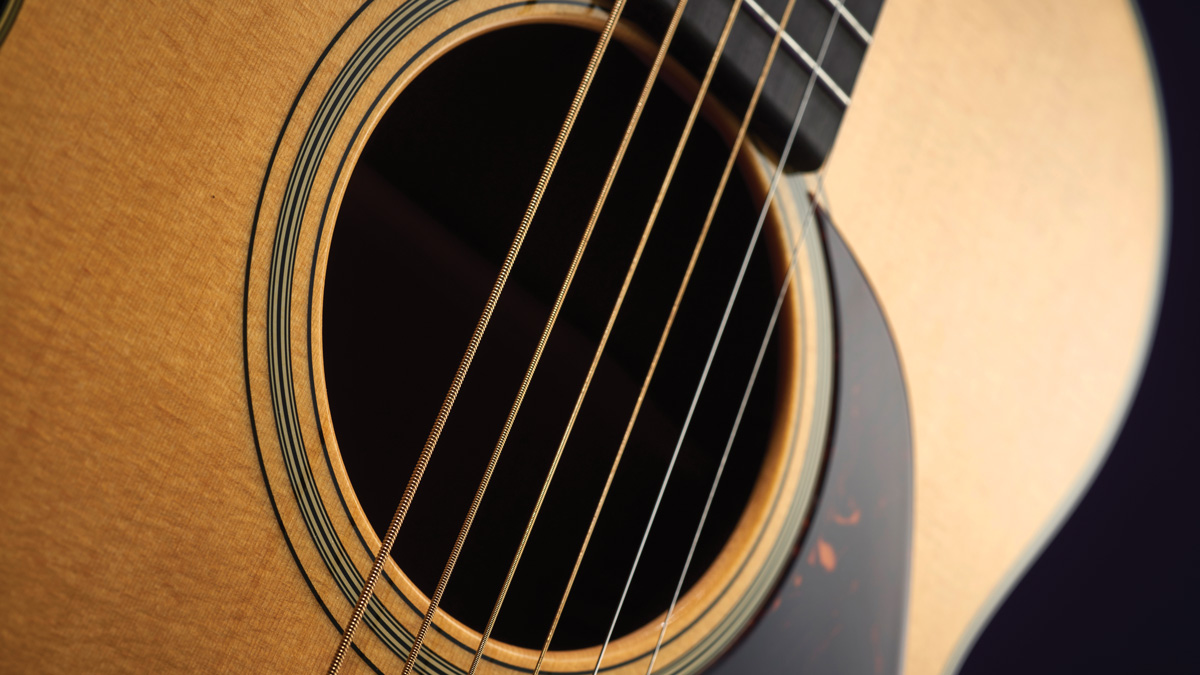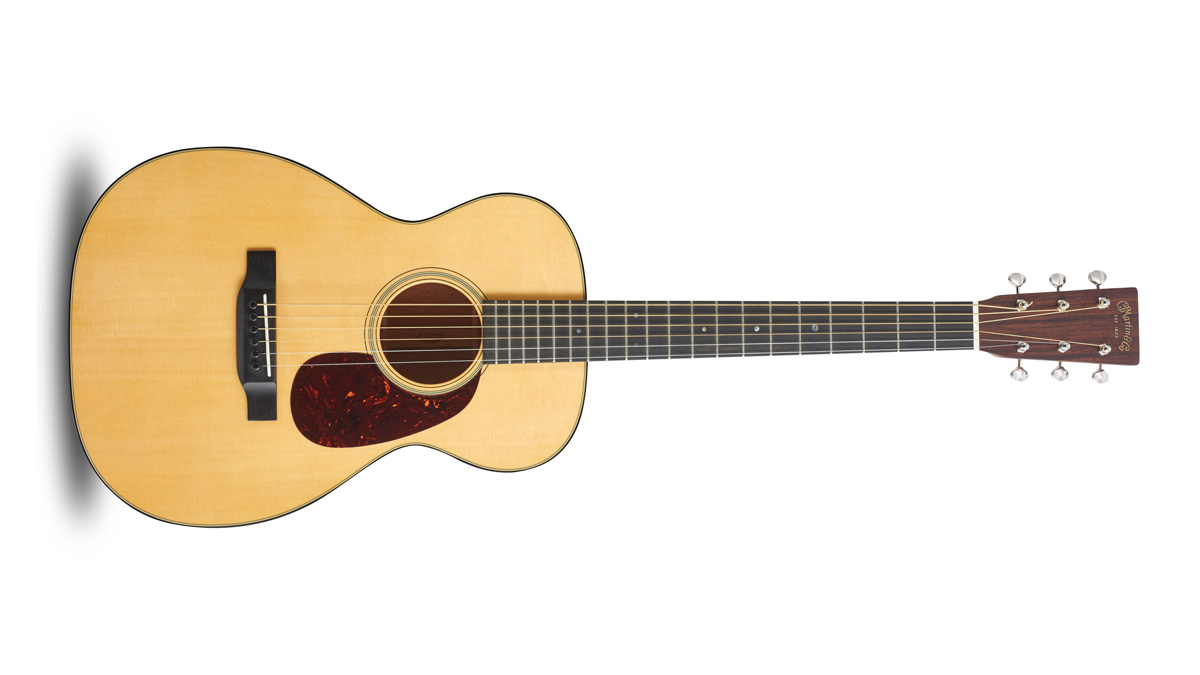MusicRadar Verdict
It gets the thumbs up from us. We’re great lovers of Parlour size acoustic guitars as they don’t spill over the tonal range when playing along with other acoustic instruments.
Pros
- +
Good looks, well-made and a great tone.
Cons
- -
The neck timber is indeterminate, although not necessarily that important.
MusicRadar's got your back
The Martin 0-18 is a parlour-sized acoustic guitar, similar in spec to the 00-18 model but with more attack and upper mids than the 00 model.
The design of this guitar incorporates many of the traditional features found on other Martin models, such as the Sitka spruce top, mahogany back and sides and the famous spade shaped headstock - you’d know it’s a Martin guitar a mile off!
The construction and build quality are superb and the attention to detail is excellent. East Indian rosewood has been used for the front of the headstock, which is adorned with the famous Martin & Co. decal.
The wood used for the neck is described by Martin as ‘selected hardwood’. We must say it looks very much like mahogany to us, being visually identical to the wood used on the back and sides of the instrument. Our suspicion is that the description used for the neck timber allows them to make changes in the event of any wood shortages, not to mention saving the rarer timbers for more visual aspects of the instrument.
The machine heads are the Grover open back type in nickel plate, similar in appearance to the vintage Waverly heads. The tuning ratio is 18:1 making for smooth accurate tuning. The fingerboard is made from Ebony and is fitted with 20 medium gauge frets and 14 abalone position markers (top and sides).
The frets are perfectly seated and very comfortable to play, with no sharp or lifting ends. The fingerboard nut is made from bone and is perfectly fitted and slotted with a comfortable first fret action height - you can easily play a barre ‘F’ chord without discomfort.

A dovetail joint is used to join the neck to the body. In our opinion this is still the best way to join the two together, even allowing for possible neck pitch problems further down the line. A glued-in neck allows for maximum resonance and transference of energy giving superior sustain.
Many manufacturers use bolt-on necks nowadays and this can bring its own set of problems if not correctly fitted. This would typically present as nodes (lack of resonance) at lower frequencies, which can affect sustain on bottom E or A strings. This certainly isn’t the case with this guitar as it has some great sustain characteristics.
The neck shape is interesting in that it isn’t the usual ‘C’ or ‘D’ shape as found on many guitars. Here’s how Martin describes the neck and playability of the 0-18: “The combination of a short expressive 24.9” (632.46mm) scale with a modified low oval neck shape and the high performance parallel taper allows for easy action and fast playability”.
Ok, you could dismiss this as typical sales talk, but the neck does feel very comfortable, even for the smallest hands. You can very easily play a regular ‘D’ chord and hold down the F# on the ‘E’ string with your thumb. The shorter scale helps too, giving rise to a softer feel to the action. The neck is finished with a matt lacquer, which is a typical Martin feature.
If we had to have just one acoustic guitar this would be a strong contender...
The top is made of Sitka spruce, which is reinforced with ¼” X bracing. As mentioned earlier, CF Martin was a major innovator of the acoustic guitar. The steel-strung guitars we have today wouldn’t exist if it wasn’t for his ground-breaking ideas.
Around 150 years ago he invented the X bracing system to help reinforce the top of the guitar. This allowed the use of steel strings for the very first time. Before this only fan style bracing was used, which provided more than adequate strength for the gut strings typically used in those days.
The old-style gut strings had a much lower tension, as do the nylon strings used for modern classical guitars, which still make use of the traditional fan bracing. The bracing on modern guitars is often ‘scalloped’ to allow the top to vibrate freely giving a better bass response.
The 0-18 has this feature but the transverse tone bars are un-scalloped allowing for better transmission of tone to other parts of the table. An ebony bridge is fitted along with an intonation compensated bone saddle which has a 16” radius. The intonation is perfect with the string 12-54 gauge as fitted from the factory. Black bridge pins are fitted to compliment the ebony bridge.
The Martin X-Bracing system has never really been improved upon (although many have tried) and is found on almost all steel strung guitars today, irrespective of price!
To compliment the look of the guitar Martin has used a gloss lacquer with an aging toner. Sitka spruce can be almost white in colour, so the use of this lacquer gives it more of a played in look. It has used a multiple black/white binding for the top and a single black binding for the back, although on closer inspection the black binding appears to be a dark faux tortoiseshell.
The depth of the binding is very narrow, looking almost like a stripe rather than a band, with a width of just 4.5mm. The binding size actually suits the look of the instrument perfectly.
We love the look of the Martin teardrop scratchplate - again faux tortoiseshell - but very attractive! The back and sides are made from a mahogany that closely resembles the Honduran species, although this is extremely unlikely. The back is in two parts with a black stripe down the middle section.
It appears that Martin still split its logs in the time-honoured fashion (rather than sawing) as the figuring on the back extends across both parts. The back is reinforced internally with four lateral spruce braces.
Both the back and the sides are finished with a faultless high gloss lacquer. The 0-18 has an unexpectedly balanced tone for its size with a pleasant emphasis on the upper mid frequencies. This makes it perfect for both strumming and fingerpicking.
The projection is excellent, with a good volume when strummed and great definition for fingerpicking. We would imagine that it would make a good recording guitar as you don’t have any of the nasty bass resonances to contend with.
We dabble in most styles of music and apart from banging out the big loud ballads (think Times Like These by the Foo Fighters) it works well and sounds great.
If we had to have just one acoustic guitar this would be a strong contender, especially if it had been fitted with a pickup. We could then happily use it for gigging and touring!
The playability, action and the feel of the neck is very good. If this is typical of the Martin factory setup then we think the majority of, if not all, players, will be happy with it.
“Every one of them said yes without hesitation": Hank Marvin and Roger Taylor have just remade a '60s classic for charity
Do you know where your money goes when you buy a gig ticket? A new report breaks it down
“Every note counts and fits perfectly”: Kirk Hammett names his best Metallica solo – and no, it’s not One or Master Of Puppets










